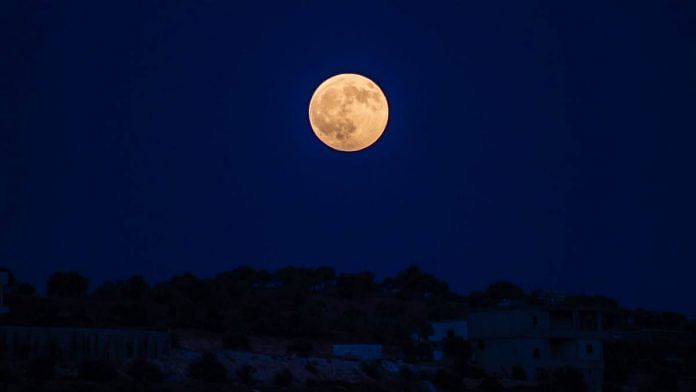New Delhi: A NASA study has revealed that the magnetic field of the ancient Moon may have served as a barrier to the harsh solar radiation raining down on the Earth-Moon system, which allowed life to evolve on Earth.
About four-and-a-half billion years ago, scorching temperatures and toxic air on Earth made life on the planet unimaginable.
Analysing lunar samples returned from the Apollo missions, scientists found that the Moon likely had a magnetic field in its early years.
In fact, the magnetospheres of the Moon and Earth were likely connected in the polar regions of each object. This played a very important role for the evolution of Earth, because the high-energy solar wind particles could not completely penetrate the coupled magnetic field and strip away the Earth’s atmosphere.
This shared magnetic field may have contributed to the Moon maintaining a thin atmosphere at that time. Scientists have earlier discovered nitrogen in lunar rock samples — which supports the idea that Earth’s atmosphere, which is dominated by nitrogen, contributed to the Moon’s ancient atmosphere and its crust.
Scientists calculate that this shared magnetic field situation could have persisted from 3.5-4.1 billion years ago. At the time, the Moon was a lot closer to the Earth, and the Earth was spinning much faster, with one day lasting only five hours. More on BGR.
Researchers achieve superconductivity at room temperature
Physicists from the US claim to have made a breakthrough in the quest for developing a superconductor at room temperature.
All materials that conduct electricity, also have some level of what is known as resistance — or the opposition to the flow of electricity. Resistance in electric conductors can be useful in some cases — such as in room heaters, but this property also reduces the efficiency of our electronic devices.
Some types of conductors, under certain conditions, offer no resistance to electricity. These materials are called superconductors. Although superconductivity has been observed at very low temperatures, at room temperature this property is thought of as the “holy grail” of energy efficiency.
Researchers have now established room temperature superconductivity in a diamond anvil cell — a small, handheld, and commonly used research device that enables the compression of tiny materials to extreme pressures.
The phenomena observed is at an early stage, but the discovery still has implications for how energy is stored and transmitted. It could also one day change how everyday devices are powered. Read more about it on The New York Times.
New species of tardigrades can survive lethal UV radiation
A team of researchers at the Indian Institute of Science has discovered a new species of tardigrades that can endure very high levels of ultraviolet radiation.
Tardigrades, also known as water bears, are microscopic aquatic animals that are known to be resilient to extreme heat, radiation, and even the vacuum of outer space.
The team at IISc has now found another species of these water bears that survives levels of radiations used to kill other types of microbes. Under a germicidal lamp that can kill bacteria and roundworms in just five minutes, 60 per cent of the tardigrades were able to survive for more than 30 days.
The water bears, found living in moss on a concrete wall in Bengaluru, turned blue under UV radiation. The team believes that fluorescent pigments, likely located under the tardigrades’ skin, transformed the UV light into harmless blue light. More about it on Science.
Half of corals from Great Barrier Reef have been wiped out in 25 years
As much as 50 per cent of the coral reefs from Australia’s iconic Great Barrier Reef have been wiped out over the last 25 years due to climate change.
The team looked at data from the reef sites between 1995 to 2017 and found that virtually all species of corals had declined. The Unesco World Heritage site had been hit by two major mass bleaching events in 2016 and 2017.
Corals provide the structures essential for spawning, nursery, breeding, and feeding grounds for numerous organisms. Coral ecosystems are a source of food for millions. They protect coastlines from storms and erosion, provide jobs and income to local economies from fishing, recreation, and tourism.
The team found that the ability of the Great Barrier Reef to recover is also compromised compared to the past. Climate crisis is driving an increase in the frequency of reef disturbances, making it difficult for the corals to bounce back. More on Independent.
Climate change wiped out ancient human species
Inability to adapt to changing climate may have wiped out several ancient human species, scientists say.
Of the six or more different species of early humans, all belonging to the genus Homo, only we — the Homo sapiens — have managed to survive.
Combining climate modeling and the fossil records, researchers looked for clues to what led to the extinction of our ancient ancestors. The team found that the extinction of at least 3 ancient human species coincided with sharp, unfavorable changes in the global climate.
The team says that these ancient human species did not lack mental power — they all had made significant technological innovations including the use of fire and refined stone tools, as well as the formation of complex social networks.
Despite that, the fact that these species could not survive climate change serves as a warning to humans today as we face unprecedented changes in the climate. More on The Telegraph.
Also read: 3 salty lakes under Mars’ surface raises possibility of life on the red planet



